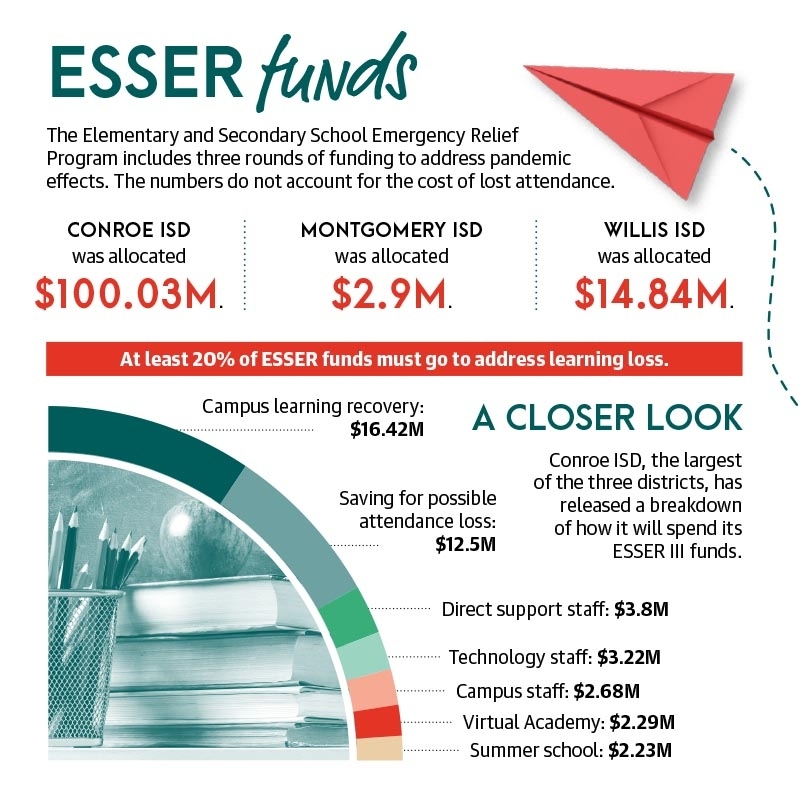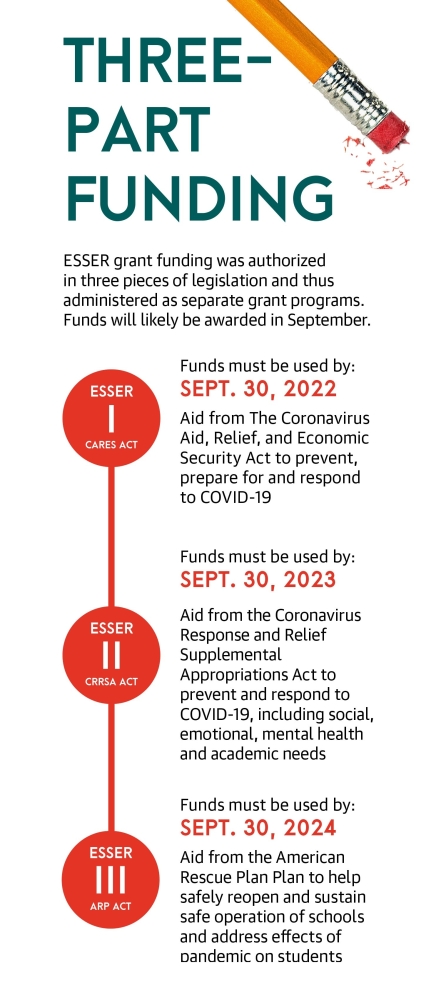The Elementary and Secondary School Emergency Relief grant funds are designed to reimburse costs related to the pandemic and combat the pandemic’s effects on students, such as their mental health. Funds can be used for expenses such as summer school, professional development and additional counselors, officials said.

The funds are split into three separate grant programs: ESSER I, ESSER II and ESSER III. In Texas, these funds are administered by the Texas Education Agency.
Conroe, Montgomery and Willis ISD are eligible for a total of $100.03 million, $2.9 million and $14.84 million, respectively, according to data from the TEA. However, costs for lost attendance still need to be deducted, so the amounts awarded will likely be significantly less, district officials said. Finalized numbers are expected in late September.
“We are really excited to have ESSER funds,” said Amy Busby, MISD assistant superintendent of student services and innovation. “[We are] exploring ... things that can supplement what great resources we already have.”
Districts generally have the flexibility to allocate the funds at their discretion, but they must follow certain guidelines. For instance, at least 20% of funds must go to address learning loss—or the loss of knowledge and skills students experience when they are not in school—according to the TEA.
Data shows learning loss occurred across the state and nation under COVID-19 restrictions, when many schools—including CISD, MISD and WISD—were operating remotely. The three districts reported between 15%-40% of students learning remotely at the start of the 2020-21 school year.
Data suggests remote learning contributed to learning loss in Texas, particularly for math, according to the TEA. Statewide, there was a 15% decline in the percentage of students doing math at or above grade level from 2019, based on 2021 scores from the State of Texas Assessments of Academic Readiness.
“This is probably 800,000 more students in Texas in mathematics that are noticeably below grade level this year as a result of COVID than in normal years,” TEA Commissioner Mike Morath said June 28 in a release.
Local school districts generally also reported lower STAAR scores across grade levels and campuses. For instance, third-grade scores in MISD reported a decrease by 12 percentage points in math. While district officials agreed ESSER funds are a much-needed boost, uncertainties about future attendance and enrollment make budget plans difficult to predict.
“Across the state there was a slowdown in growth, and we had some kids that did not return to school,” said Greg Smith, executive director of The Fast Growth School Coalition. “Going into [this] year, if enrollment does not creep back up, then they’ll have to make some budgetary decisions based on decrease in enrollment.”
Understanding the funds
ESSER I was authorized in the Coronavirus Aid, Relief, and Economic Security Act signed in March 2020. ESSER I funds reimburse for costs related to preventing, preparing for and responding to COVID-19, such as cleaning supplies.
In December, ESSER II was authorized under the Coronavirus Response and Relief Supplemental Appropriations Act. In addition to the same criteria as ESSER I, these funds can also be used for the pandemic’s effects on the social, emotional, mental health and academic needs of students.
The American Rescue Plan Act, signed in March, authorized ESSER III. ESSER III funds are to be used to help safely reopen and sustain the safe operation of schools and to address the pandemic’s effects on students, such as learning loss.
At CISD, funds will be used for expenses such as summer school, hiring additional campus staff, technology support and campus learning recovery, according to the district website.
“It’s a very diverse plan. It kind of targets a lot of areas,” CISD Deputy Superintendent Chris Hines said.
MISD is still finalizing its plans, but ideas include hiring additional staff for special education and counseling; updating technology, such as improving the student information system; purchasing additional instructional and curriculum materials; enhancing the summer school program; and supporting professional development, officials said.
At WISD, Director of Communications Jamie Fails said funds will be used for social and emotional assistance, health and sanitation, facility enhancements related to COVID-19, technology needs and to address learning loss.
Enrollment and attendance
During a normal school year, districts in Texas are granted state funds based on student attendance and enrollment. TEA data shows enrollment decreased for CISD and MISD from 2019-20 to 2020-21, but WISD added 17 students in that time.To alleviate the financial stress, Gov. Greg Abbott and the TEA announced in March the state would continue its hold harmless to Texas schools for the 2020-21 academic year. This means funding would be made available to districts even if they saw enrollment and attendance declines because of the pandemic as long as they maintained or increased current levels of on-campus attendance.
However, this money comes out of ESSER II funds, Hines said. District officials are also uncertain what enrollment and attendance numbers will look like this year.
“If students drop off with respect to attendance throughout the course of [this] year, the districts by and large will have enough to limp along the rest of the school year,” Smith said. “If you start declining, then you’ve got to put some things on the back burner such as building schools, adding staff and so on.”
Still, Smith said he expects statewide there will be about 266,000 new students or students that return to school in the 2021-22 academic year. And fast-growth districts—or districts with enrollment growth over the last five years of at least 10% or a net increase of 3,500 or more students—will likely continue to see growth in enrollment, he said. CISD, MISD and WISD are all fast-growth districts.
For instance, CISD in-person enrollment decreased from 64,798 in 2019-20 to 54,251 in 2020-21 but is projected to be 66,298 in 2021-22.
Learning loss
Under pandemic restrictions, local school districts were forced to pivot to remote learning. Once restrictions eased, districts had to balance remote offerings as well as traditional in-person learning.Remote learning generally contributed to student learning loss, which is measured in test scores, officials said.
WISD students generally saw lower STAAR results from spring 2019 to spring 2021 across all subject areas, except for fifth-grade reading and sixth-grade reading. MISD students scored lower in spring 2021 compared to spring 2019 in all subject areas, save seventh-grade writing. CISD students scored lower in all subject areas.
“I do not think that virtual learning was set up for kindergarten through 12th graders to learn six, seven hours a day online,” Smith said. “That’s a lot to ask for kids. That’s a lot to ask for parents and certainly a lot to ask for teachers.”
During the 87th Legislature, the state nixed funding for remote learning for the 2021-22 academic school year. However, CISD Superintendent Curtis Null announced Aug. 6, as a response to the resurgence of COVID-19, the district is offering a limited, application-based virtual program for students in pre-K through sixth grade for the first semester of 2021-22.
Ally Bollender contributed to this report.





